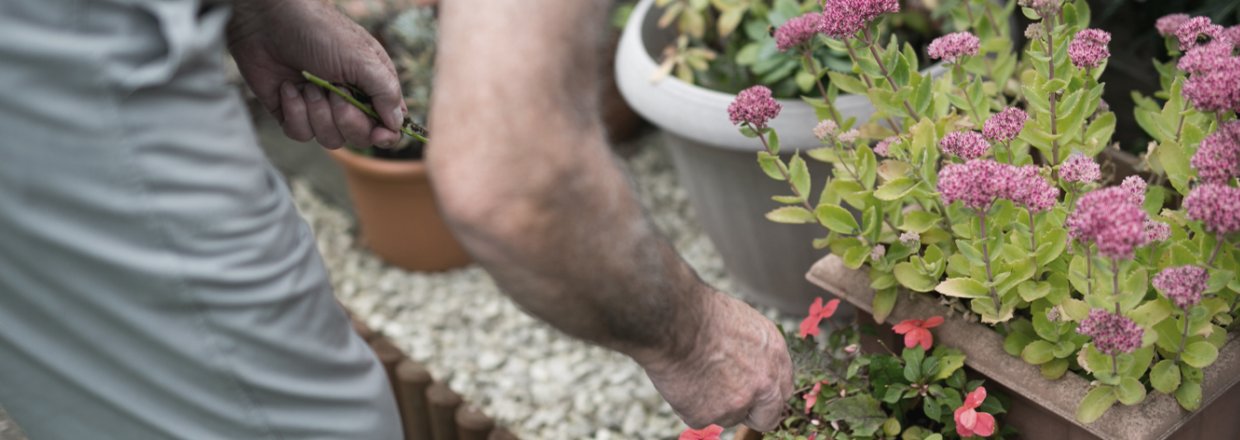As a condition that affects the brain, movement and musculoskeletal health (MSK) those with Parkinson’s may benefit from certain exercises and activities, which can be done individually or with the help of relatives, friends or carers.
To help with this, we asked our Senior MSK Physiotherapist Rachael Newman, who has experience in neurological rehabilitation, to share her advice on what exercises and activities may be of particular benefit to those with Parkinson’s.
What is Parkinson’s disease and how does it affect movement?
Parkinson’s disease is a condition affecting the brain that slows down movement, affects your walking and impairs your thought processes. Everyone is affected differently, but most commonly it can lead to issues such as muscle stiffness, reduced balance, and finding it hard to start movements - such as standing up or taking a first step.
Due to these symptoms people often find that day-to-day life becomes challenging. Furthermore, studies show there is an increased risk of falls, with around half of people with Parkinson’s having a fall each year. Physical activity is a great way to address these issues.
What kind of stretches should people with Parkinson’s disease do?
There are a number of stretches and activities that can help people with Parkinson’s to tackle muscle stiffness. They include:
- ‘Seated hamstring stretch’ - sit towards the edge of your chair with one leg in front of your body with the heel on the floor, then sit up tall to stretch your spine and hold it.
- ‘Reaching in sitting’ – reach as far forwards as you feel you can safely go. Then do the same, reaching out to each side.
- ‘Standing side bend’ (you can also do this in a seated position if preferred) - keeping your feet and legs together, reach both arms up over your head and inhale, then, putting your right arm down to your side, reach your left arm over your head and bend your body slightly to the right, as you exhale.
- ‘Sitting wood chop’ – start by taking your hand to the opposite ankle, then reach the same arm diagonally up to the sky and then back down to the ankle, as if you are chopping wood.
- ‘Lying twist’ - lie on your back with your arms extended out to the side before raising your legs in the air with your knees slightly bent. Then, lower your legs to one side until the outside of your thigh touches the floor, before raising them again and lowering them to the other side.
What are some helpful strengthening exercises for people with Parkinson’s?
Building up strength can help those with Parkinson's to reduce the risk of falls and injuries. Some strengthening exercises can include:
- ‘Sit to stand with arm reach’ - with your weaker arm, reach diagonally up and to the side and, from a seated position, stand up while continuing to reach up diagonally. This forces you to move your weight through your weaker leg.
- ‘Marching on the spot’ – really exaggerate the movement of your arm swings and knee lifts with this simple exercise.
- ‘Side stepping’ – stand with your legs together and step to the side, bending your knees into a squat as the foot lands on the floor. For an extra challenge you can add a resistance band around your knees.
- ‘Throw and catch a ball’ - a good one for football fans, this simple overhead throw exercise is great for building strength.
More inspiration for strengthening exercise and support can be found on the newly launched "Stronger My Way" hub from the Chartered Society of Physiotherapists (CSP).
Every person’s abilities will be different so, if you’re unsure on what is safe for you to do, it is always best to speak with a physiotherapist to get a tailored exercise program.
Can dancing work?
Putting on a familiar, favourite song and having a dance around with your partner, family member or carer is a great activity to help with strengthening, improving balance and getting stiff muscles moving! It can also be easier to initiate movement with music playing and stepping in time to the song.
Get moving with cueing
For people that struggle with initiating movements, cueing can be really effective. It can be as simple as counting "1,2,3,4" in your head with the intention of taking a first step on 1 and stepping in time with the counting. Cueing strips or blocks can also be placed on the floor to help with taking larger steps. Some walking aids project lines onto the floor wherever you are walking to help with this, such as a laser cane.
What other activities could you do?
Almost any activity that gets you moving can have benefits for people with Parkinson’s disease. You could try:
- PD warrior 10 week challenge - this is a Parkinson’s specific exercise to help you improve symptoms.
- Going out for walks - getting out and about in the fresh air can be really beneficial. Walking at a pace so that you feel some exertion, and add some marching swings for extra benefits.
- Tai chi - this gentle exercise style uses movement and mindfulness to increase flexibility, strength and balance, and research suggests it can reduce falls.
- Gardening - gardening is a great way to stay active and to keep your hands busy. It’s also good for mental health.
- Yoga - through body postures, simple meditation and breathing techniques, yoga can improve balance and flexibility and reduce stiffness.
What new physiotherapy techniques are coming down the track that might help people with Parkinson’s?
Our understanding of Parkinson’s disease and how best to manage symptoms is constantly improving. Companies like Strolll are developing innovative ways of using technology to improve mobility with visual and audible cues simulated by an AR headset.
